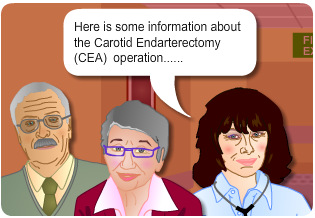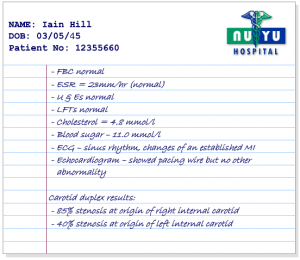Iain is anxious about the surgery, and his wife has lots of questions.

A carotid endarterectomy (CEA) is an operation to remove the atheromatous plaque which causes narrowing of the artery.
A CEA may be carried out under general or local anaesthetic. The surgeon makes a 3 inch cut in the side of the neck. During the operation the artery is temporarily clamped so that it can be opened and cleaned out.
Patients will normally be in hospital for 2-3 days.
Following a discussion of the potential risks and benefits of carotid endarterectomy, Iain agrees to be referred to the vascular surgeon for a possible right carotid endarterectomy. For information on possible right carotid endarterectomy see topic loop below. Depending on local service configuration carotid artery stenting may be an option.
Topic loop:

Following the diagram below we know that:
- Iain has had a minor ischaemic stroke
- No rare causes were identified
- His carotid duplex showed severe stenosis so a carotid endarterectomy is likely to reduce his risk of further stroke. See Topic Loop on right for further information.
- His ECG showed sinus rhythm
- He has been prescribed Clopidogrel and the doctor advised short term dual antiplatelet treatment
- He is already on cholesterol reducing drugs
- He is already taking medication to lower his blood pressure
- A HbA1c test has been arranged. See Topic Loop below for further information.
- Lifestyle behaviour changes should be used in conjunction with drug therapy to reduce the risk of recurrence – in particular he should give up smoking!
Topic Loops:
Iain comes back to the TIA Clinic with his wife, he has just been to have his carotid duplex and the doctor has the results of his tests from the previous day. The doctor explains that although the CT scan was normal it is important to realise that this does not exclude a stroke. After a minor ischaemic stroke the CT brain scan is often normal.

For further information on diabetes management see Topic Loop below.
Topic Loop:
Ian has had a CT scan that has excluded haemorrhage and confirming a right hemisphere ischaemic stroke. His weakness is non disabling, and he wants to come home but is asked to come back to clinic. He has been asked not to drive for the time being and is prescribed clopidogrel 75mgs. Iain is at increased risk of further stroke
For further information on understanding risk see Topic Loop below.
Topic loop:

This is the module test for ‘Cognition and perception’. It is strongly recommended that you work through the learning materials of the module prior to commencing this test. By going straight to the test you may miss out on valuable learning contained within the module. The answers to all the test questions are contained within the module. This information may have been provided in the ‘Additional Information’ boxes on some of the pages.
There are 20 questions and you must answer all of these correctly to obtain a certificate of completion.
You should allow approximately 20 minutes to complete the test.
Clinically, Iain has had a right cerebral stroke. There are a number of tests which could now be carried out. (See the Additional Information below for further information on these tests).
Q. Which of the following tests could Iain have?
For further information on atrial fibrillation and carotid intervention see Topic Loops below.
Topic Loops:
Q. What blood tests could Iain have? Select the crosses next to the blood tubes below to find out more about the tests.
Protocols regarding which blood tests are taken can. So remember to refer to your local procedures.
For further information on rarer causes of stroke see Topic Loops below.
Topic Loops:






